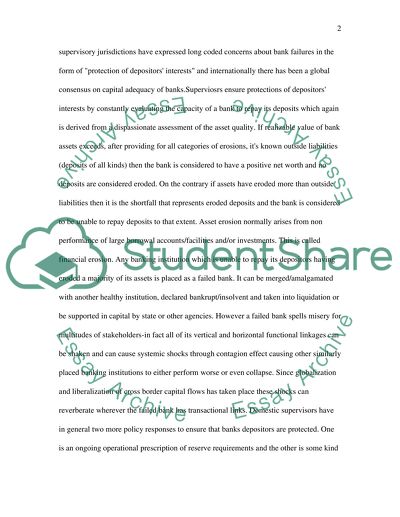CHECK THESE SAMPLES OF Study of Banking Crises and Failures
In the study of Coulbeck (1984), the emphasis is given on the following fact: in the USA, banking activities have been always quite developed; in 1940 the banks operating across the USA were estimated to 5,144 while in 1980 the above number has been decreased to 4,425.... This case study "Financial Institutions Strategic Management – The USA Banking Industry" discusses the severe failures in managing risks related to banking activities that led to the recession of 2008, which still negatively influences markets worldwide....
9 Pages
(2250 words)
Case Study
Among the problems faced may be attributed to human frailty, institutional failures, lack of proper policies to regulate the flow of funds as well as cultural… Additionally, environmental degradation has also been reported to escalate global problems (Brown, pp2-3).... Among the problems faced may be attributed to human frailty, institutional failures, lack of proper policies to regulate the flow of funds as well as cultural origins to mention just but a few (Harvey)....
2 Pages
(500 words)
Case Study
From the paper "The Collapse of American International Group" it is clear that the stakeholder that felt the collapse of the Company financially was the individual taxpayer, this is because the Federal government used a lot of money to bail out the company.... nbsp;… AIG credit default swaps were insurance contracts that were unregulated, therefore, AIG did not put anything any capital as collateral and it maintained what can be described as an AAA credit rating....
9 Pages
(2250 words)
Case Study
The paper "Financial Crisis, Home Mortgages, Financial Institutions and Adverse Selection" describes that financial crisis that has currently occur in different parts of the world has highlighted limitations of financial innovation.... The cause of the financial crisis is the financial instruments that are used in the economies....
5 Pages
(1250 words)
Case Study
The "The Efficiency of the banking Sector in the US" paper focuses on The efficiency of the US banking industry which has been proved to be satisfactory – despite the fact that a high number of banks in the US have collapsed since the beginning of the crisis....
8 Pages
(2000 words)
Case Study
hree days after the initial news, the government announced that it will guarantee all Northern Rock savings deposits, in order to calm an increasingly apprehensive banking public.... This paper "The Impact of the Global Credit Crisis On Northern Rock of UK" focuses on the fact that on Sept....
10 Pages
(2500 words)
Case Study
This paper "Undergoing an Internship at ATF Bank – Kazakhstan" focuses on the fact that the internship at ATF Bank in Kazakhstan provided significant experience regarding management structuring, HR, working with customers in the finance industry, and interpersonal communication skills development....
10 Pages
(2500 words)
Case Study
This paper "Causes of Unemployment" discusses Joblessness or Unemployment that refers to a state of not having a job experienced by those people who are willing to work at the going rates of labor but are unable to secure a job.... Today, several hundred people are on the payroll.... hellip; The rates of the unemployed persons are much higher in the regions of western and southern Africa and the Middle East region....
9 Pages
(2250 words)
Case Study


